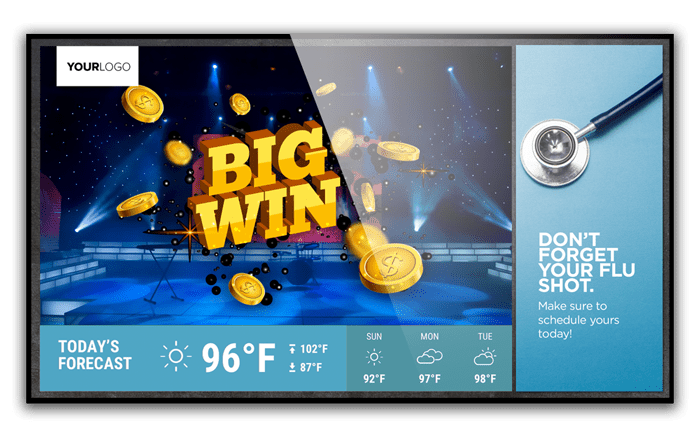6 pași pentru o experiență mai bună a pacientului
Asigurarea unei experiențe cu adevărat excepționale pentru pacienți merge dincolo de asigurarea unui nivel ridicat de îngrijire.
Este vorba despre crearea unui mediu relaxant și prietenos în toată unitatea dumneavoastră– nu unul fad sau prea clinic.
Scopul ar trebui să fie reducerea stresului și a anxietății din momentul în care pacienții și membrii familiilor acestora intră pe ușă.
Un mod de a face acest lucru este să luați în considerare ceea ce văd, aud și simt atunci când se află în cabinetul dumneavoastră.
Atunci când sunt utilizate în mod eficient, soluțiile media din domeniul sănătății, cum ar fi muzica, mesajele în așteptare, semnalizarea digitală și parfumurile, vă pot ajuta să abordați aceste aspecte și să îmbunătățiți semnificativ experiența pacientului.
Care este rezultatul?
O mai mare satisfacție a pacienților, mai multe recomandări din gură în gură și o impresie remarcabilă care vă distinge cabinetul de restul.
În acest articol, vă vom explica cum puteți utiliza cel mai eficient aceste soluții media pentru a obține rezultate atât de bune.
#1: Redați muzica potrivită.
A asculta muzica potrivită pentru asistență medicală nu înseamnă a asculta doar ceea ce vor să audă recepționerii.
Deși este important să țineți cont și de preferințele lor, preferințele pacienților și ale membrilor familiei acestora trebuie să fie întotdeauna pe primul loc.
Luați în considerare vârsta și datele demografice ale vizitatorului dvs. mediu și găsiți programe muzicale înălțătoare și relaxante care să se adreseze generației lor.
Deoarece muzica pe care o puneți în cabinetul dumneavoastră este folosită în scopuri profesionale, programele ar trebui să provină de la un furnizor profesionist de muzică medicală.
Aceste companii plătesc de obicei taxele de licență pentru muzică în numele dvs. (nu uitați că difuzarea de muzică de la radio sau de la o aplicație de streaming pentru consumatori în cabinetul dvs. încalcă legile federale privind licențele).
În plus, colaborarea cu un furnizor experimentat de muzică medicală vă va oferi acces la o varietate de programe concepute profesional, astfel încât să puteți pune muzica potrivită pentru vizitatorii și personalul dumneavoastră. Furnizorul de servicii vă poate ajuta chiar să selectați programele potrivite pentru cabinetul dumneavoastră.
Soluția pe care o utilizați ar trebui să vă permită, de asemenea, să programați programe diferite pentru a fi difuzate în momente diferite ale zilei – o strategie cunoscută sub numele de “dayparting”.
Pentru furnizorii de servicii medicale, recomandăm programarea unor programe care oferă o energie mai ușoară dimineața, urmată de programe ceva mai optimiste după-amiaza și seara devreme.
În cele din urmă, muzica medicală trebuie să fie de încredere.
Ultimul lucru pe care vi-l doriți sunt întreruperile de streaming, secvențe ciudate între melodii sau tăcerea completă din cauza faptului că internetul nu funcționează în locația dvs.
#2: Implicarea pacienților cu ajutorul semnelor digitale.
Semnalizarea digitală în domeniul sănătății nu mai este o tendință – este un instrument extrem de eficient pe care tot mai mulți furnizori îl folosesc pentru a educa și a implica pacienții și membrii familiilor acestora – în timp ce creați o experiență mai bună și vă îmbunătățiți imaginea profesională. În plus, aplicațiile de afișaj digital în domeniul sănătății sunt mai eficiente din punct de vedere al costurilor și mult mai eficiente decât cele tipărite. Cu majoritatea soluțiilor de afișaj digital, puteți actualiza și programa conținutul instantaneu, utilizând un portal web. Nu mai trebuie să așteptați ca semnele să se întoarcă de la tipografie și nu mai trebuie să plătiți taxe de tipărire. Doar o rată lunară simplă, care se ridică de obicei la câțiva mărunțișuri pe zi.
Rețineți că semnalizarea în domeniul sănătății are diverse forme și aplicații și servește unei varietăți de scopuri.
Utilizările tipice includ:
- Cozi de așteptare a pacienților
- Divertisment în sala de așteptare
- Căutare
- Sfaturi de sănătate, recomandări dietetice
- Reamintiri de programare
- Tablouri de meniu pentru cafenea
- Aspecte vizuale/estetice ambientale
- Comunicații interne
În plus, din ce în ce mai multe unități o folosesc pentru a comunica cele mai bune practici importante de siguranță, cum ar fi “vă rugăm să păstrați o distanță de 1,80 m” și “evitați să vă atingeți fața”.

Nu numai că adaugă valoare și comoditate pentru vizitatorii dumneavoastră, dar le oferă o impresie bună despre cabinetul dumneavoastră – o impresie care îi face să se gândească: “Acest doctor are o facilitate foarte frumoasă”.
Acesta este genul de impresie care va contribui în mare măsură la diferențierea cabinetului dumneavoastră de concurență, ajutându-vă în același timp să obțineți mai multe recomandări din gură în gură.

#3: Aveți grijă la programare.
Programele pe care le afișați pe televizoarele dumneavoastră sunt foarte importante.
Scopul ar trebui să fie crearea unei experiențe primitoare în sala de așteptare, care să distreze și să reducă stresul, iar conținutul de programare trebuie să contribuie la atingerea acestui obiectiv.
Ultimul lucru pe care doriți să îl faceți este să contribuiți la creșterea stresului prin difuzarea de conținut neplăcut, cum ar fi știrile negative sau emisiunile de televiziune și filmele cu subiecte violente sau nepotrivite.
În plus, nu puteți controla ce reclame sunt afișate la televiziunea de rețea, dar doriți cu adevărat ca o reclamă a unui concurent să apară pe ecranele dumneavoastră?
În cele din urmă, faptul de a trebui să vă ridicați și să schimbați canalul la fiecare 15 minute pentru a satisface un pacient este o pierdere de timp pentru personalul dumneavoastră și contribuie la creșterea nivelului de stres al acestuia.
La urma urmei, îngrijirea pacienților este destul de dificilă.
O modalitate simplă de a ocoli aceste probleme este înlocuirea televiziunii în direct cu o soluție de programare în format scurt. Programarea de scurt metraj oferă clipuri de 1-3 minute din emisiuni TV populare și este înfășurată într-un șablon de marcă care oferă spațiu pe ecran pe care îl puteți folosi pentru a adăuga și mai multă valoare experienței pacientului. De asemenea, puteți intercala programe de scurt metraj cu conținut pe tot ecranul personalizat pentru marca dvs.
În orice caz, fiți întotdeauna atenți la divertismentul pe bază de televiziune pe care îl oferiți.
Afișarea unei programări nepotrivite este contrară creării unei experiențe liniștitoare de care pacienții dumneavoastră au nevoie atunci când se află în sala de așteptare.
# 4: Recepționați mesajul.
Mesajele de așteptare sunt încă (și vor fi întotdeauna) un element critic al experienței pacientului. On-hold poate părea o necesitate banală pentru cabinetul dumneavoastră, dar adevărul este că poate fi un instrument util și eficient care îndeplinește mai multe scopuri:
Maximizați eficiența personalului. La un nivel de bază, mesajele de așteptare permit personalului să prioritizeze în mod corespunzător pacienții care sosesc la fața locului și apelurile în ordinea în care sunt primite.
În plus, puteți utiliza mesageria de așteptare pentru a elibera coada de așteptare, direcționând apelanții către site-ul dvs. web pentru a găsi informațiile pe care le caută.
Promovați-vă cabinetul. Mesajele de așteptare sunt un mijloc excelent pentru a furniza informații despre serviciile de sănătate specifice pe care le oferiți în unitatea dumneavoastră.
De exemplu, puteți configura mesaje sezoniere pentru programarea vaccinurilor antigripale în toamnă și a imunizărilor pentru întoarcerea la școală în timpul verii.
Dacă aveți un centru de imagistică sau o farmacie la fața locului, puteți, de asemenea, să promovați aceste facilități în mesajele dumneavoastră.
Posibilitățile sunt cu adevărat infinite.
Promovarea bunăstării. De asemenea, puteți utiliza mesageria pentru a oferi sfaturi importante privind sănătatea și bunăstarea.
Pacienții dvs. nu numai că vor aprecia informațiile, dar vor aprecia și nivelul suplimentar de atenție pe care îl demonstrați.
Astfel de sentimente pot contribui în mare măsură la crearea unui nivel profund de loialitate a pacienților, ceea ce poate duce la mai multe recomandări din gură în gură.
Îmbunătățirea experienței pacientului. Pur și simplu, muzica și mesajele de așteptare ar trebui să fie o extensie a experienței primitoare pe care doriți să o creați la fața locului.
Oferirea de valoare celor care vă apelează în timp ce așteaptă le va oferi o experiență pozitivă în așteptare, ceea ce contribuie la satisfacția lor generală față de cabinetul dumneavoastră.
În timp ce apelantul obișnuit nu petrece mult timp în așteptare, acest timp reprezintă o oportunitate unică de a urmări mai multe obiective de afaceri.
Folosiți-o în avantajul dumneavoastră.
#5: Leverage Scent.
Poate că ne adresăm unui cor, dar legătura dintre miros și emoțiile și amintirile noastre este prea puternică pentru a fi respinsă.
Profitați de marketingul olfactiv pentru a spori sentimentul de primire și de relaxare al cabinetului dumneavoastră pentru vizitatori și personal.
De asemenea, puteți utiliza parfumuri specifice pentru a reduce și mai mult stresul pacienților în anumite zone ale cabinetului dumneavoastră, cum ar fi sălile de imagistică sau de examinare.
În cele din urmă, mirosul este o modalitate excelentă de a minimiza percepția oricăror mirosuri și de a vă asigura că cabinetul dumneavoastră face o impresie de curățenie și igienă.
Găsiți o companie locală de marketing olfactiv care poate recomanda parfumuri specifice pentru industria medicală.
De asemenea, vă vor sugera sistemele de difuzie potrivite pentru instalația dumneavoastră și pentru nevoile dumneavoastră.
#6: Folosiți sisteme AV de calitate comercială și specialiști AV în domeniul sănătății.
Sistemele audiovizuale sunt responsabile pentru mai multe elemente ale experienței pacientului, de la muzică de fundal și semnalizare digitală la televiziune, mascare a sunetului și sisteme de paging. AV intră, de asemenea, în joc pentru soluțiile pentru săli de conferințe și proiectoare, permițându-vă să vă implicați și să vă educați mai bine echipa.
Utilizarea unor componente AV fiabile de calitate comercială este esențială pentru a asigura că aceste elemente funcționează în mod constant la un nivel ridicat.
Ecranele și difuzoarele de calitate comercială pot costa ceva mai mult, dar având în vedere fiabilitatea și garanțiile complete pe care le oferă, acestea reprezintă o investiție mult mai inteligentă decât echipamentele de consum, din mai multe motive.
Spre deosebire de omologii lor profesioniști, difuzoarele și ecranele de consum nu sunt concepute pentru a funcționa continuu timp de mai multe ore, iar fiabilitatea poate deveni o problemă după câteva săptămâni de utilizare regulată într-un mediu medical.
În plus, utilizarea unui ecran de consum într-un mediu de afaceri va anula orice garanție cu care este prevăzut.
Pe de altă parte, ecranele și difuzoarele de calitate comercială sunt însoțite de garanții complete care vă pot economisi sute de euro în cazul în care sunt necesare reparații sau înlocuiri.
În cele din urmă, este important să angajați un expert în audiovizual specializat în proiectarea și instalarea de echipamente audiovizuale pentru unitățile sanitare.
Instalatorul dumneavoastră trebuie să fie foarte familiarizat cu aspectele unice și cu cerințele de codificare electrică ale unei unități sanitare.
De asemenea, vă vor putea ajuta să determinați cantitatea potrivită de acoperire audiovizuală de care aveți nevoie în anumite zone specifice ale cabinetului dumneavoastră și vă vor sugera soluții care să ofere doar performanța de care aveți nevoie – nici mai mult, nici mai puțin.
În cele din urmă, calitatea îngrijirii pe care o oferiți este esențială pentru experiența pacientului, dar încorporarea elementelor pe care le-am discutat în acest whitepaper va contribui în mare măsură la îmbunătățirea acesteia.
Rezultatul este un nivel mai profund de loialitate a pacienților, care vă îmbunătățește rezultatele financiare și îmbunătățește percepția pacienților dumneavoastră cu privire la nivelul de îngrijire pe care l-au primit.
Contactați-ne astăzi pentru mai multe informații despre îmbunătățirea experienței pacienților cu ajutorul soluțiilor Healthcare media sau pentru a programa o consultație gratuită. De asemenea, puteți afla mai multe accesând pagina noastră de asistență medicală.
RĂMÂNEM CONECTAȚI
Contactați-ne astăzi pentru a îmbunătăți experiența clienților dumneavoastră.
"*" indicates required fields
